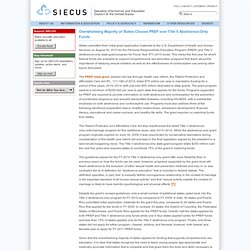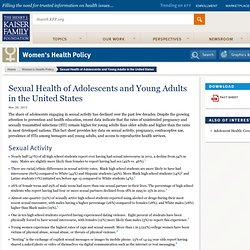

School-Based Sexuality Education: The Issues and Challenges. Family Planning Perspectives Volume 30, Number 4, July/August 1998 By Patricia Donovan In fall 1997, the Franklin County, North Carolina, school board ordered chapters on sexual behavior, contraception and AIDS and other sexually transmitted diseases (STDs) cut out of its health textbook for ninth graders.

The deleted material, the board said, did not comply with a new state law requiring public schools to teach abstinence until marriage in their comprehensive health education program for students in kindergarten through ninth grade. The school board also instructed teachers to discuss only failure rates in response to students' questions about contraceptives. The board's new policy is a compelling example of the controversy raging in many communities over what public schools should teach in sex education classes.
State legislatures are also feeling the pressure. Efforts to undermine sexuality education are not new, of course. SEX_EDUCATION. 12_Abstinence%20Only. SIECUS. States submitted their initial grant application materials to the U.S.

Department of Health and Human Services on August 30, 2010 for the Personal Responsibility Education Program (PREP) and Title V abstinence-only state-grant program for Fiscal Year (FY) 2010 funds. This marks the first year for which federal funds are available to support comprehensive sex education programs that teach about the importance of delaying sexual initiation as well as the effectiveness of contraceptive use among other topics discussed. The PREP state grant, passed into law through health care reform, the Patient Protection and Affordable Care Act (P.L. 111-148) of 2010, totals $75 million per year in mandatory funding for a period of five years, 2010–2014, with just over $55 million dedicated to state grants. The grant program awards a minimum of $250,000 per year to each state that applies for the funds. Governor Bob McDonnell of Virginia has also opposed the new health care reform law.
Reproductive Health - The Office of Adolescent Health. Reproductive Health - The Office of Adolescent Health. 3040-05-2.pdf (application/pdf Object) Mar 28, 2013 The share of adolescents engaging in sexual activity has declined over the past few decades.

Despite the growing attention to prevention and health education, recent data indicate that the rates of unintended pregnancy and sexually transmitted infections (STI) remain higher for young adults than older adults and higher than the rates in most developed nations. This fact sheet provides key data on sexual activity, pregnancy, contraceptive use, prevalence of STIs among teenagers and young adults, and access to reproductive health services.
Sexual Activity Nearly half (47%) of all high school students report ever having had sexual intercourse in 2011, a decline from 54% in 1991. Figure 1: Pregnancy, Birth, and Abortion Rates Among Teens Have Been Steadily Declining in the U.S. Pregnancy The pregnancy rate among female teens ages 15-19 in 2008 was 67.8 per 1,000, a drop of 58% since the peak in 1990. Contraception. Office of Adolescent Health - The Office of Adolescent Health. The Case for a New Approach to Sex Education Mounts; Will Policymakers Heed the Message? Guttmacher Policy Review Spring 2007, Volume 10, Number 2 By Heather D. Boonstra Abstinence-only-until-marriage education is a key component of social conservatives’ global moral and religious agenda, and the cornerstone of the Bush administration’s approach to reducing U.S. teen pregnancy and sexually transmitted infection (STI) rates.
Since 1996, when a major overhaul of the nation’s welfare policy prompted a massive escalation of funding in this area, the federal government, with mandatory matching grants from the states, has spent well over one billion dollars to promote premarital abstinence among young Americans, through highly restrictive programs that ignore or often actively denigrate the effectiveness of contraceptives and safer-sex behaviors. Facts on American Teens' Sexual and Reproductive Health. May 2014 •Fewer than 2% of adolescents have had sex by the time they reach their 12th birthday.

But adolescence is a time of rapid change. Only 16% of teens have had sex by age 15, compared with one-third of those aged 16, nearly half (48%) of those aged 17, 61% of 18-year-olds and 71% of 19-year-olds.[1] There is little difference by gender in the timing of first sex. •On average, young people have sex for the first time at about age 17, [2] but they do not marry until their mid-20s.[3] This means that young adults may be at increased risk for unintended pregnancy and STIs for nearly a decade or longer. •Teens are waiting longer to have sex than they did in the recent past. •In 2006–2010, the most common reason that sexually inexperienced teens gave for not having had sex was that it was “against religion or morals" (38% among females and 31% among males). •Teen sex is increasingly likely to be described as voluntary. . • Contraceptive use at first sex has increased over time. STIs 1. 2. Facts on American Teens’ Sources of Information About Sex.
February 2012.
